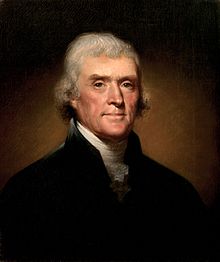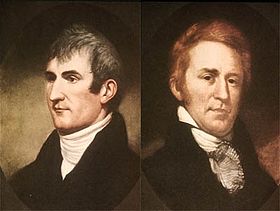May 14, 1804
Today sees the beginning of a historic adventure that will change course of the history of a fledgling country. This adventure will last two years, four months and ten days. The two men who will lead the expedition are handpicked by the President Thomas Jefferson. The idea for

this trip came to him in 1803, after he had concluded a major land deal known as the Louisiana Purchase. He decided he wanted to know just what he had bought for his money so he had asked for some volunteers to check it out for him. Their long and arduous trip lasted from May 1804 to September 1806. Their main goal was to explore and the area and make maps showing what they found, so others could follow their trail west across the continent and plant their flag, so to speak, in case other countries decided to claim it. These two men had volunteered to do the job, and they took a few others with them. But these two men, and their followers, had a second goal that was actually just as important as the first. They were to document all the area’s plants, animal life, and geography, and also to establish a trading relationship with the local Native American tribes.
In the winter of 1804–05, the party built Fort Mandan, near the present-day city of Washburn, North Dakota. As a safety precaution, before they moved on, in order to protect what they had achieved so far, the expedition sent the keelboat back to Saint Louis with a sample of specimens on 7 April 1805, some of which never seen before anywhere east of the Mississippi. The Americans quickly continued westward (upriver), and camped for the winter in the Mandan nation’s territory. Here they met a French-Canadian fur trapper named Toussaint Charbonneau, and his young Shoshone wife Sacagawea. Her place in American history is probably more established than his. Charbonneau at this time began to serve as the expedition’s translator. Peace was established between the expedition and the Mandan chiefs with the sharing of a Mandan ceremonial pipe.
The Corps of Discovery, as this expedition was known, eventually met their objective of reaching the Pacific, mapping and establishing their presence for a legal claim to the land. They also established trade relations with at least two dozen nation of the various Indian cultures. Although they didn’t find a continuous waterway to the Pacific Ocean, they did manage to locate trail used by the Indians to travel from the upper end of the Missouri River to the Columbia River which ran to the Pacific Ocean. They also gained valuable and previously unknown information about the natural habitat, the animals and the various plants and grasses, bringing back a multitude of seed, plant, and mineral specimens. They mapped the landscape, showing the location of rivers, streams and mountains, and of course, the various Indian tribes and their territories as they passed through the previously unexplored land. They also learned and recorded much about the language and customs of the American Indian tribes they encountered, and brought back many of their artifacts, including bows, clothing and ceremonial robes. They were therefore, in essence, the first souvenir collectors in America. The expedition helped establish the U.S. presence in the newly acquired territory and beyond and opened the door to further exploration, trade and scientific discoveries. Who were these two intrepid explorer? Why, Meriwether Lewis and William Clark, of course.

To purchase a signed copy of Larry Auerbach’s novel “The Spirit Of Redd Mountain”, Click Here
Photo courtesy of wikipedia.com

